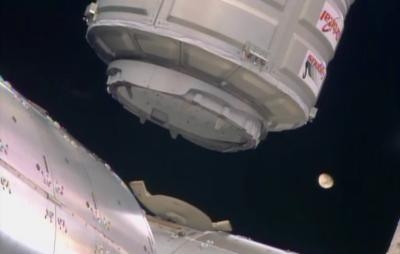Tue, Jan 14, 2014
Commercial Resupply Spacecraft Cygnus Spacecraft Docked At ISS Sunday
The commercial space industry took another step forward Sunday as astronauts aboard the International Space Station used a robotic arm to capture and attach the Cygnus supply spacecraft, which carried dozens of new science experiments from across the country and the world to the orbiting laboratory. The arrival capped the first successful contracted cargo delivery by Orbital Sciences Corp. of Dulles, VA for NASA.

Astronaut Mike Hopkins of NASA grappled the spacecraft at 0608 EST and Koichi Wakata of the Japan Aerospace Exploration Agency attached Cygnus to the space station's Harmony Node at 0805. The Expedition 38 crew members aboard the station will begin unloading the 2,780 pounds of supplies aboard Cygnus following hatch opening planned for Monday.
The cargo is comprised of vital science experiments, crew provisions, spare parts and other hardware. This includes 23 student-designed science experiments. One newly arrived investigation will study the decreased effectiveness of antibiotics during spaceflight. Another will examine how different fuel samples burn in microgravity, which could inform future design for spacecraft materials.
Orbital's Cygnus was launched on the company's Antares rocket Thursday from the Mid-Atlantic Regional Spaceport Pad 0A at NASA’s Wallops Flight Facility in Virginia. Cygnus will remain attached to Harmony until a planned unberthing in February sends the spacecraft toward a destructive re-entry in Earth's atmosphere.
Orbital Sciences is one of two companies that built and tested new cargo spacecraft under NASA's Commercial Orbital Transportation Services (COTS) program. COTS was completed late last year with an Orbital Sciences demonstration mission to the space station. Space Exploration Technologies (SpaceX), the other company that partnered with NASA under COTS, also is providing commercial resupply services for the agency. U.S. commercial cargo delivery flights to the station help ensure a robust national capability to deliver critical science research to orbit, significantly increasing NASA's ability to conduct new science investigations aboard the only laboratory in microgravity.
In addition to cargo flights, NASA's commercial space partners are making progress toward a launch of astronauts from U.S. soil within the next three years.
(Image provided by NASA)
More News
Airplane Bounced About 3 Ft Then Touched Back Down And Then, With No Brakes Applied, The Airplane Began Veering To The Left Analysis: The pilot entered the airport traffic pattern >[...]
Aero Linx: British Microlight Aircraft Association (BMAA) The primary focus within all aviation activity is SAFETY. In all aspects of our sport SAFETY must come first, whether it b>[...]
From SnF25 (YouTube Edition): William Wynne Builds Practical Aircraft Engines on the Corvair Platform Seeking an affordable alternative to the traditional aircraft engine options, >[...]
How To Get A Story On Aero-TV News/Feature Programming How do I submit a story idea or lead to Aero-TV? If you would like to submit a story idea or lead, please contact Jim Campbel>[...]
From 2023 (YouTube Edition): Bridge of CiES CiES Inc. is a Bend, Oregon-based designer and manufacturer of modular embedded aircraft systems and sensors. The company’s fuel-l>[...]
 NTSB Final Report: Aviat A1
NTSB Final Report: Aviat A1 ANN's Daily Aero-Linx (07.08.25)
ANN's Daily Aero-Linx (07.08.25) Classic Aero-TV: Fly Corvairs Reliable Engine Alternative
Classic Aero-TV: Fly Corvairs Reliable Engine Alternative ANN FAQ: Contributing To Aero-TV
ANN FAQ: Contributing To Aero-TV Classic Aero-TV: CiES Fuel-Quantity and e-Throttle Systems Praised
Classic Aero-TV: CiES Fuel-Quantity and e-Throttle Systems Praised



